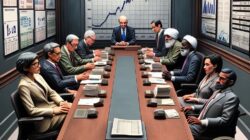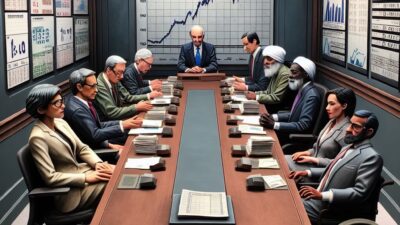The U.S. Economic Landscape: A New Era Begins with the President-Elect
Date: October 2023
A Robust Economy: The President-Elect’s Promising Start
As the United States welcomes a new president-elect into the highest office, the nation finds itself in a surprisingly strong economic position. With employment rates at all-time highs and GDP growth exhibiting consistent upward trends, the incoming administration stands on a foundation of optimism. However, beneath this seemingly buoyant surface lies a complex array of challenges that investors are keenly considering as they adjust their expectations for future growth.
Understanding the Current Economic Climate
The U.S. economy is characterized by low unemployment rates, robust consumer spending, and a resilient stock market. Recent reports indicate that consumer confidence remains high, which is vital for sustained economic activity. The housing market, too, continues to experience steady growth. Demand for housing exceeds supply in numerous regions, contributing to rising property values.
However, it is essential to recognize the challenges that could impede this growth trajectory. Supply chain disruptions, stemming from past global events, still linger, affecting various sectors, including manufacturing and retail. Rising interest rates, implemented as a strategy to curtail inflation, could also dampen consumer spending and business investments. As the president-elect takes office, balancing these factors will be crucial for maintaining economic momentum.
Investor Sentiment: Cautious Yet Optimistic
Investor sentiment plays a significant role in shaping economic expectations. While the current economic outlook is positive, market participants exhibit a cautious optimism. Analysts expect the president-elect’s administration to prioritize policies that enhance economic growth, such as boosting infrastructure investments, expanding clean energy initiatives, and improving job training programs.
Despite these hopes, investor confidence can rapidly shift in response to policy changes or unforeseen economic events. Many are closely monitoring the behaviors of the Federal Reserve, particularly regarding interest rate adjustments. Any indication of aggressive rate hikes could lead to market volatility, foreshadowing challenges to capitalize on the current economic highs.
Challenges on the Horizon
As the president-elect prepares to implement their agenda, several challenges loom over the economic landscape. The ongoing battle against inflation remains a primary concern. Inflation rates, while showing signs of stabilization, linger above the Federal Reserve’s target level. If the new administration cannot effectively manage inflationary pressures, it could lead to a double-edged sword of rising prices and diminishing purchasing power for consumers.
Additionally, geopolitical tensions and global supply chain issues pose significant risks. The interconnected nature of today’s economy means that any instability abroad can quickly reverberate within the U.S. market. Stakeholders are keeping a close eye on international trade relationships and any potential disruptions that may arise during the transition of power.
The Role of Infrastructure and Investment
One of the pivotal strategies expected to emerge from the president-elect’s agenda is a significant investment in infrastructure. With aging infrastructure in dire need of modernization, such initiatives promise to create jobs, stimulate economic growth, and improve overall productivity. These investments can serve as a catalyst for economic expansion, especially in rural and underserved urban areas.
Moreover, tackling challenges related to climate change through sustainable energy projects is anticipated to be at the forefront of the new administration’s agenda. By promoting renewable energy solutions and sustainable practices, the incoming government hopes to create a greener economy while simultaneously generating new jobs within this burgeoning sector.
Looking Ahead: Balancing Ambition with Realism
As the new administration begins to take shape, there is significant anticipation regarding the policies that will be proposed and enacted. Investors and analysts alike remain optimistic but aware that achieving sustained economic growth requires a realistic assessment of the barriers that exist. The ability to create a practical roadmap that addresses both immediate concerns, such as inflation and supply chain issues, along with long-term objectives, including infrastructure development, will be crucial.
The president-elect will be evaluated not just on their promises but on their ability to navigate the complexities of the current economic landscape. Remaining flexible and adaptive to unforeseen challenges while adhering to a long-term vision will be critical components of their success—or failure.












